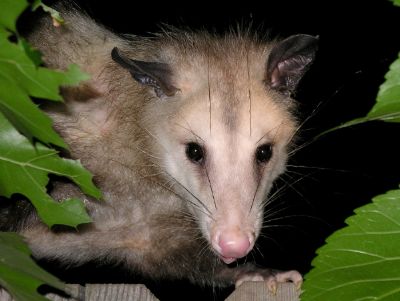by Valerie
November, 2004Virginia Opossum One of our more amusing backyard visitors is the Virginia opossum (Didelphis virginiana). The largest of about 65 species of marsupials in the New World, this is the only one found north of Mexico, ranging from Canada to Nicaragua. The opossum lives throughout most of the US, even though it is not well adapted to extreme cold. The bare tail and ears are susceptible to frostbite, and northern animals are sometimes missing bits from these extremities. The most unique feature of opossums is, of course, their method of bearing young. Unlike all the other mammals in our country, which are placental, meaning the young are carried to term within a uterus, the opossum is a marsupial and possesses a pouch in which the young develop after a very brief gestation period. The baby opossums are born no more mature than a fetus and manage to crawl to the pouch, where they attach to the mother's teats and complete their growth. Once the young outgrow the pouch, they stay with their mother for a while longer, clinging to the fur of her back until they are too large for that as well. Opossums are not swift animals, physically or mentally. They are nocturnal, but can sometimes be found out in the open during early morning hours. I encounter them fairly frequently on walks and also in our backyard as they are climbing along the back fence. They cannot outrun most predators and so instead have a variety of behaviors for defense. Although their constant drooling (the animal in the photo has the typically drippy nose, but it doesn't show well in the reduced web version) is enough to make me not want to get too near, they do have a couple other tricks. Opossums have a mouthful of teeth, including large canines which can inflict a wicked bite. They are also expert, but slow, climbers and will retreat up a tree if possible. The most famous of their behaviors, though, is feigning death, or "playing 'possum." Even after seeing this happen numerous times, I can't really tell if the animal does it instinctively, or if it is involuntary. I suspect the former, partly because I've seen individuals assume a disgustingly realistic corpse-like pose, complete with lips drawn back as if in a death grin, tongue partly hanging out, head folded under their chest, and eyes tightly shut, only to open one eye to check things out if they think that I've gone away. They are also quite capable of grasping onto sticks, rocks, or anything else if they feel they are going to be dragged away. While the opossums in our yard here in Texas often act entertainingly naive, as when they become confused and waddle back and forth, over and over again, between overhanging branches along our back fence, much like a target in a shooting gallery, the funniest encounter I had with the beasts occurred when I lived in Tallahassee, Florida. Upon hearing a loud rustling in the fallen leaves outside my window one night, I took a flashlight out to investigate. There I found, racing around and around a 10-foot long segment of concrete block wall, a rather small female opossum being closely tailed by a larger amorous male. Instead of running anywhere else, they continued this same path for several minutes, with the female getting farther and farther ahead of the tiring male (who was making increasingly loud grunting/panting sounds), until she was almost right behind him. I then made the mistake of stepping back a bit and the male heard my movement. He immediately changed direction and headed towards me, most likely assuming that the noise was the female having moved off that way. As I didn't know what a frustrated male opossum might do, I beat a hasty retreat back to the house, easily outpacing the worn out marsupial. |
(More information on opossums is available in "larvalbug's garden.")